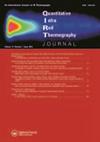应用红外热成像技术检测喷气发动机短舱内固定结构粘接板蜂窝与复合材料面板之间的脱粘
IF 4.9
3区 工程技术
Q1 INSTRUMENTS & INSTRUMENTATION
引用次数: 14
摘要
内固定结构(IFS)粘接板是一种蜂窝状夹层板,一侧为碳纤维增强塑料面板和隔热罩,另一侧为多孔碳纤维增强塑料面板。双面承受极端温度,会破坏面板与蜂窝芯之间的内部环氧胶粘剂粘合。使用常规方法对这一层进行无损评估是极具挑战性的。这项工作提出了主动热成像技术,如闪光热成像和感应热成像,以进入内层。红外摄像机利用IFS键合板表面的穿孔(用于衰减发动机噪声)对缺陷进行成像。然而,闪光热成像需要去除隔热层进行检查,而感应热成像可以在不改变结构的情况下进行。使用这些技术可检测到的最小脱键尺寸受限于面板上孔眼之间的间距。本文开发了一个用于感应热成像的数值模型,以优化激发频率,使其能够在内层表面产生合理的热对比,并在覆盖隔热层的中间不锈钢薄板上产生最小的温升。本文章由计算机程序翻译,如有差异,请以英文原文为准。
Detection of dis-bond between honeycomb and composite facesheet of an Inner Fixed Structure bond panel of a jet engine nacelle using infrared thermographic techniques
ABSTRACT The Inner Fixed Structure (IFS) bond panel is a honeycomb sandwich panel with CFRP facesheet and a heat shield on one side, and a perforated CFRP facesheet on the other side, of a jet engine nacelle. It is subjected to extreme temperature on both sides which damages the inner epoxy adhesive bond between the facesheet and the honeycomb core. Accessibility to this layer for non-destructive evaluation is extremely challenging using conventional methods. This work proposes active thermography techniques such as flash thermography and induction thermography for accessing the inner layer. The infrared camera utilises the perforations in the facesheet of the IFS bond panel, which is used for attenuating the engine noise, for imaging the defects. However, flash thermography requires the removal of the thermal insulation layer for the inspection, whereas induction thermography can be performed without any modifications to the structure. The minimum detectable dis-bond size using these techniques is restricted to the spacing between the perforations on the facesheet. A numerical model has developed for induction thermography to optimise the excitation frequency that can produce reasonable thermal contrast at the inner facesheet and minimum temperature rise on the intermediate stainless-steel thin sheet that covers the thermal insulation layer.
求助全文
通过发布文献求助,成功后即可免费获取论文全文。
去求助
来源期刊

Quantitative Infrared Thermography Journal
Physics and Astronomy-Instrumentation
CiteScore
6.80
自引率
12.00%
发文量
17
审稿时长
>12 weeks
期刊介绍:
The Quantitative InfraRed Thermography Journal (QIRT) provides a forum for industry and academia to discuss the latest developments of instrumentation, theoretical and experimental practices, data reduction, and image processing related to infrared thermography.
 求助内容:
求助内容: 应助结果提醒方式:
应助结果提醒方式:


